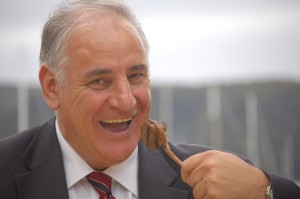The big battle in the livestock and meat markets of the world is being fought between industrially produced fish and industrially produced chicken. And, according to Imperial College London’s food marketing professor David Hughes, it is a fight Australia’s beef and lamb industries should do everything they can to avoid.

David Hughes
“That is the real bare fisted, eye gouging, bare knuckled fight for protein markets, and why is that? Because it is intensively produced, and it is relatively low cost,” Prof. Hughes told a 900-strong crowd at the Lambex conference in Adelaide yesterday.
“You want to keep away from that big battle, because if you get involved in that battle you will get your clocks cleaned.”
Rather, if you’re in the lamb or beef business, it was important to understand you are in the “premium minority meat business”.
This was not a bad thing because large and growing markets exist for premium quality meat in both developed and emerging markets.
The challenge for Australian producers is that the cost of entry to these markets is gradually rising as the “green bar” in terms of consumer expectations about product integrity and sustainability continually climbs higher and higher.
Professor Hughes said consumers will pay a premium for three things in food: “great taste, is the product consonant with my lifestyle and values, and then the story”.
And surrounding that was the broader trend towards more natural, simpler and safe foods, which was also the dominant theme of an address to Lambex yesterday by Meat & Livestock Australia’s global marketing manager Michael Edmonds.
Professor Hughes told Sheep Central that being able to demonstrate the environmental and sustainable credentials of a product would be the cost of entry to these premium markets.
“If you are a premium product, the ticket to entering premium markets is ticking the green boxes, and doing the environmental social things well, that gives you the right to be in a premium market, then you have to deliver on taste, and then have the story.”
This leads to the controversial area of electronic tagging of sheep. Just as their counterparts were in the cattle industry 10 years ago, many sheep producers remain resistant to the idea of having to fund the cost of introducing individual electronic identification across their entire flocks for the right to access markets that they can already access without EID.
However, in Professor Hughes’ view, the adoption of EID is an inevitable cost Australia’s sheepmeat industry will have to carry to maintain access to premium markets in future.
“I would suggest that moving towards electronic tagging of sheep, you are absolutely going in that direction, and what is more, if you look at the premium end, and that it is a premium meat, people just expect it.
“As it is, they think you already know, they think you already have that information
“Who is going to pay for it? Well that is the price of entering premium markets.”
“They just expect that, the green bar is going up, you don’t get a premium for being sustainable, you get a discount if you don’t.”
Versatility, convenience must be addressed
Professor Hughes told the conference that 45 years ago he completed a PhD specialising in lamb marketing and concluded at the time that lamb was seen as “lacking versatility and convenience”.
“I would suggest that is still a problem today,” he said.
“45 years on there has been lots of improvement, but in terms of making a product which is consonant with the lifestyle of particularly of younger consumers and households elsewhere, they struggle with lamb and we need to put it in a form that is just easier to use.”
It was intriguing, he said, that many Australians listed lamb as their favourite meat in consumer surveys but conceded they only ate it about every three weeks or so.
“That is not often for your favourite meat, I think we have got to do more on convenience,” he said.
Have Sam’s ads run their course?
 Professor Hughes said another key challenge for lamb going forward domestically is to encourage more under-40 year-olds on a consistent basis to see there is relevance in lamb for them for their families and their lifestyle.
Professor Hughes said another key challenge for lamb going forward domestically is to encourage more under-40 year-olds on a consistent basis to see there is relevance in lamb for them for their families and their lifestyle.
While the industry clearly had achieved strong results with the Sam Kekovich led advertising campaigns for the past 10 years or so, he said the campaigns appealed to an older demographic and may not be as effective in reaching the under-40s.
“Whether they are Kekovich people is questionable.”

HAVE YOUR SAY